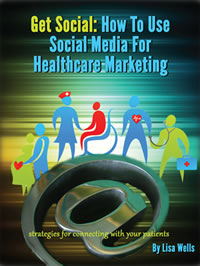Observation Deck
Online, You Get What You Give
Many providers might have their online marketing and social media strategies backwards.
 “Your website ain’t a field of dreams.” One of my most
trusted mentors said that to me years ago. I should probably preface his quote
by explaining that although my mentor’s nickname happens to be Bubba, he
also happens to be one of the most distinguished media personalities in his
trade over the last 50 years.
“Your website ain’t a field of dreams.” One of my most
trusted mentors said that to me years ago. I should probably preface his quote
by explaining that although my mentor’s nickname happens to be Bubba, he
also happens to be one of the most distinguished media personalities in his
trade over the last 50 years.
“Bubba,” aka John E. Phillips, was recently inducted into the Hall of Fame
for his industry, and he was one of the first media professionals in his field to
embrace the concepts of e-marketing and e-books. And most importantly, he’s
absolutely right.
The biggest mistake that any HME can make is to dump a bunch of money
and time into cramming all of the bells and whistles and animated GIFs that
can fit into a “new and improved” web site, and then sit back expecting the
e-stampede to automatically begin.
Online behavior simply doesn’t work that way, regardless of how well-known
your brand is or the size of your organization.
In healthcare marketing, it’s even more important to ditch the “field of
dreams” mentality because of the changing nature of our business due
to reimbursement cuts. Contrary to the CMS Fraud Police’s opinion, the
majority of us are here to serve a community in need – but most of us are not
natural marketers.
We’re paperwork processors, documentation experts and clinically trained
in health or medical topics.
That’s why your community looks to you, as a health care provider, for
answers to what concerns them. You calm their fears and alleviate their pain
by giving them hope and help in preserving their quality of life.
And now, more than ever before, your customers are looking for – and then
at – your online resources for this type of assistance. The secret to growing
your virtual healthcare audience is based on what you share, not what you
sell, online.
Let’s go back to the baseball analogy for a second.
Baseball is all about the score, and all about who walks away at the end of
the game as the winner. It’s not about the experience, is it? The coach might say
‘no’, because winning is how they keep their job. However, the fan – who pays
to be there – more than likely says ‘yes.’ If the experience didn’t play a role in
customer loyalty, no one would show up after the first game the team lost.
You Might Have It Backwards
It seems counter intuitive to suggest that a for-profit, competitive-biddingchallenged
HME organization should give more than they get. Naturally, you
can’t keep the doors open if you’re not making a profit. Please know I agree
with you.
I am not saying you shouldn’t be “selling” online. I am saying you will
capture a larger audience if you are selling an experience or a solution instead
of a transaction to the people who visit your web site. This applies to cashonly
medical supply sites too.
Brand experts all agree, the strongest brands stand for something. The best
brands convey a meaning that holds a value. Apple, for example, has a brand
identity of being leading-edge, hip, cool and fun – not just as a company, but
also in terms of how their products define the person who owns them. That
wasn’t an accident. Apple’s brand identity was cultivated.
What do your brand stand for? Do you know? To answer that, let’s go
through the following exercise:
- First, ask yourself, what are you cultivating for your company’s brand image?
- Now, the first five adjectives that come to mind about your organization.
- Okay, now look at those adjectives.
- How many of them revolve around serving an individual’s personal health
needs?
Let’s consider your answers. If your brand differentiation list is more about
achieving your organization’s financial goals, or one-upping the competition,
rather than serving your customer’s personal needs, you are cultivating an
insular brand - one that will have a hard time being readily accepted by the
masses. More importantly, your retention rate will be negatively impacted.
Simply put, customers aren’t as loyal to that kind of brand as they are to one
that focuses on the individual.
There are cases in the healthcare industry where inward-facing branding
makes sense. For example, B2B technical service providers need to be fully
focused on the benefits of their technology.
You’re probably not going to see a document-imaging system or a billing
software solution sharing their softer side through their marketing efforts. But
even they will focus on solving the business needs of their clients through
what they offer as a solution.
However, if you don’t get a warm and fuzzy feeling about your personal
healthcare provider, chances are you won’t have a strong personal tie to the
organization.
So, what kind of image are you giving off about your organization through
your communication channels? Remember, the web is just one of your
customer touch points.
You Get What You Give, So Give More
Don’t start off by selling on social media. If your posts sound like “it’s all about
you,” that will guarantee only your mother and your employees [maybe] will
follow your newsfeed. Instead, open the conversation with a question or congratulate
someone who is using your products to live a better, longer life. Then
mix in your offers or deals of the day.
At the very least, make it absolutely clear that you care about your
customers, in everything you say and do, but especially in the intentional
tone and approach you take online.
 Lisa Wells, president of Get Social Consulting
(Tampa, Fla.; getsocialconsulting.com), connects
healthcare providers with consumers who are online
and in-store. A veteran of online marketing and
electronic commerce, Wells has more than 20 years
of experience in marketing and product management
at medical device, medical supply and health
technology organizations. She has advised on
successful digital marketing programs and strategic
marketing plans for HME providers and medical
device manufacturers in the United States, Canada
and Europe. Wells recently hosted “Social Media
That Sells,” an HMEB panel webinar on how HME providers can better
connect with their clients, which is available for replay at hme-business.com/webinars. Her books, including “Get Social: How to Use Social Media for
Healthcare Marketing,” can be purchased on Amazon. Wells can be reached
at [email protected].
Lisa Wells, president of Get Social Consulting
(Tampa, Fla.; getsocialconsulting.com), connects
healthcare providers with consumers who are online
and in-store. A veteran of online marketing and
electronic commerce, Wells has more than 20 years
of experience in marketing and product management
at medical device, medical supply and health
technology organizations. She has advised on
successful digital marketing programs and strategic
marketing plans for HME providers and medical
device manufacturers in the United States, Canada
and Europe. Wells recently hosted “Social Media
That Sells,” an HMEB panel webinar on how HME providers can better
connect with their clients, which is available for replay at hme-business.com/webinars. Her books, including “Get Social: How to Use Social Media for
Healthcare Marketing,” can be purchased on Amazon. Wells can be reached
at [email protected].
This article originally appeared in the September 2016 issue of HME Business.